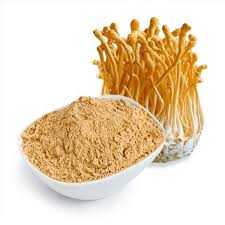List Of Medicinal Benefits of Cordyceps
November 13, 2020
|
7 min read
What is Cordyceps?
Cordyceps is a fungus that lives on certain caterpillars in the high mountain regions of China. It is a genus of parasitic fungi that grows on the larvae of insects.
When these fungi attack their host, they replace its tissue and sprout long, slender stems that grow outside the host’s body.
Supplements and products containing Cordyceps extract have become increasingly popular due to their many purported health benefits.
Cordyceps is used to treat coughs, chronic bronchitis, respiratory disorders, kidney disorders, nighttime urination, male sexual problems, anemia, irregular heartbeat, high cholesterol, liver disorders, dizziness, weakness, ringing in the ears, unwanted weight loss, and opium addiction.
It is also used for strengthening the immune system, improving athletic performance, reducing the effects of aging, promoting longer life, and improving liver function in people with hepatitis B.
Some people use cordyceps as a stimulant, a tonic, and an “adaptogen,” which is used to increase energy, reduce fatigue and enhance stamina.

Recommended read: Boost Immunity using Cordyceps
Do you know this?
Have you seen or heard anything about science fiction movies? This superfood could star in a leading role. Cordyceps mushrooms, also known as the caterpillar fungus, are a renowned supertonic – building sexual and physical power, mental energy, the immune system – all while prolonging life.
They hold a place as one of my personal favorites in herbalism. However, cordyceps are also parasitic organisms that consume the body of a particular kind of caterpillar in mountainous regions of China, Mongolia and Tibet.
Though very unusual, they are outrageously advantageous for your health, these fungi are an extremely effective and powerful life-enhancing agent, competing in goodness right up there with ginseng, reishi and deer antler as one of the most beneficial substances in tonic herbalism.

Why you should try it?
Although the thought of consuming such a strange food might creep you out, it is worth giving a try. These mushrooms have profound health benefits. Used to strengthen the body and mind from the core, they are able to increase our “inner force for life activities”, which helps the body by acting as a stress buster and controls the process of aging, which is something we all can benefit from.
In Traditional Chinese Medicine, cordyceps are widely used for the purposes of strengthening the primal kidney functions, which include brain power, skeletal structural integrity and the harnessing of your power and motivation.
As a sexual tonic, cordyceps are considered to be one of the best – one reason why they are so popular among the male gender. Cordyceps are also considered in Asia to be a powerful athletic tonic, greatly improving performance and muscle building capabilities. Is there anything this little weird herb cannot do?

Convinced that Cordyceps is a SUPERFOOD?
So now when you agree that cordyceps should become a daily addition to your health regime, then let’s talk about how you’re going to consume it. There are two ways—one for the brave and one for the more faint of heart.
- If you are fearless and looking for a culinary adventure, then you are going to want to try Cordyceps Munchables by Dragon Herbs. Dried and packed into a bag, they can be eaten as a crunchy snack or soaked in hot water to be sipped as a tonic.
- For the rest of us, there is a supplement form, which comes in many herbal blends like Adaptogen Energizer.
Composition of Cordyceps Used in Medicines
Medicinal mushrooms have been known for thousands of years to produce bile metabolites which are used or studied as possible treatment for diseases. Over two-third of cancer-related deaths could be prevented or reduced by modifying our diet with mushrooms, as they contain antioxidants. Cordyceps have a history of medicinal use spanning millennia in parts of Asia. The name Cordyceps has been derived from two Latin words, i.e., cord and ceps meaning club and head, respectively.
Cordyceps militaris belongs to the phylum Ascomycota classified in the order hypocreales, as spores are produced internally inside a sac, called ascus. It is an entomopathogenic fungus having an annual appearance which often grows parasitically on lepidopteran larvae and pupae of insects and spiders. It normally inhabits the surface of insects pupae in winters and leading to the formation of fruiting bodies in summers justifying its name as “winter-worm summer-grass”.
Cordyceps has been found mainly in North America, Europe and Asia. In India, it is prominently found in subalpine regions of grassy lands of Himalayas commonly known as “Keera Ghas”. Recently it has been reported from Sutol and Kanol villages of Chamoli district of Uttarakhand.
The ethnopharmacological use of Cordyceps sinensis has been reported from western Nepal for the cure of different diseases like diarrhea, headache, cough, rheumatism, liver disease, etc. This herb is also referred as “Himalayan Viagra” or “Himalayan Gold” due to its broad clinical and commercial value. Cordyceps requires a specific set of conditions for its growth and has small size; therefore, the large-scale collection of this mushroom is a daunting task.
However, people within the age group 15–65 years including men, women, young boys and girls are the main collectors of this fungus and price for 1 kg of wild-collected mushroom in the market of Nepal varies from 30,000 to 60,000 Nepali Rupees while in India it costs about Rupees 100,000.
Past 5 years have seen tremendous exploitation of Cordyceps which has significantly reduced its wild occurrence. Efforts have been made to artificially cultivate this mushroom by surface and submerged fermentation techniques.
There have been a variety of pharmacologically active compounds (e.g., Cordycepin) reported from Cordyceps sp. Cordycepin has received much attention due to its broad-spectrum biological activity. It is known to interfere with various biochemical and molecular processes including purine biosynthesis, DNA/RNA synthesis and mTOR (mammalian target of rapamycin) signaling transduction.
Cordyceps has been included as one of the growing numbers of fungal traditional Chinese medicine (FTCM) used as cures for modern diseases with many products available commercially. Due to recent advancements in pharmaceutical biotechniques, it is possible to isolate bioactive compounds from Cordyceps and make it available in powder as well as in capsular form (e.g., Didanosine).
Cordyceps and its product have remarkable clinical health effects including action on hepatic, renal, cardiovascular, respiratory, nervous, sexual, immunological systems, besides having anti-cancer, anti-oxidant, anti-inflammatory and anti-microbial activities.
The inhibitory effect of Cordycepin in mono- and tri- phosphate states on the enzymes, phosphoribosyl pyrophosphate synthase and phosphoribosyl pyrophosphate amidotransferase, involved in purine biosynthesis pathway. The addition of Cordycepin as a Co-TP (Cordycepin triphosphate) leads to transcriptional termination.
Cordycepin presumably activates the AMPK by some unknown mechanism which further negatively regulates the translation of mTOR signaling transduction pathway by the formation of a translational repressor, 4-E-binding protein-1 (4EBP1)
Keeping in view of the above facts, the current review updates us with the recent research pertaining to Cordyceps and the bioactive compounds isolated from it; especially for its ethno-pharmacological use. The study brings together a variety of mechanisms of Cordycepin at one platform and more importantly the broad spectrum pharmacological, clinical or biological activities associated with Cordyceps.
Diseases Cordycepsis believed to cure:

- Kidney damage caused by the drug amikacin.Early research shows that using cordyceps with the drug amikacin might reduce kidney damage caused by the drug in older people.
- Asthma. Early research suggests that taking cordyceps alone can reduce asthma symptoms in adults. However, other early research suggests that taking cordyceps along with other herbs for 6 months does not reduce the need for medication or improve asthma symptoms in children.
- Chemotherapy. Early evidence shows that taking cordyceps by mouth during or after chemotherapy might improve quality of life and improve tolerance to the treatments.
- Kidney damage caused by the drug cyclosporine.There is early evidence that taking cordyceps with cyclosporine can reduce kidney damage caused by cyclosporine in people with kidney transplants.
- Hepatitis B.Early evidence shows that taking cordyceps by mouth might improve liver function in people with hepatitis B. However, cordyceps seems to be less effective than astragalus and polygonum (fo-ti).
- Sexual desire.Early research suggests that taking a specific cordyceps product (CordyMax Cs-4) daily for 40 days can improve sex drive in people with low sex drive.
- Kidney transplant.Early research suggests that taking cordyceps (Bailing capsules) daily for up to 2 years together with conventional treatments does not improve survival in people who received a kidney transplant. However, taking cordyceps might reduce the need for some conventional treatments and the number of infections and other complications. Also, early research suggests that taking cordyceps (Bailing capsules) twice daily for 9 months together with the blood pressure-lowering drug enalapril improves kidney function and slows the progression of the disease in patients with declining kidney function after a transplant.
- Promoting longevity.
- Decreasing fatigue.
- Cough.
- Bronchitis.
- Breathing disorders.
- Male sexual dysfunction.
- Anemia.
- Heart arrhythmias.
- High cholesterol.
- Liver disorders.
- Dizziness.
- Weakness.
- Ringing in the ears.
- More evidence is needed to rate the effectiveness of cordyceps for the above uses.
Common side effects of cordyceps include:
- Increased symptoms of autoimmune diseases
- Increased risk of bleeding during surgery
- Slow blood clotting (increased risk of bleeding in people with bleeding disorders)
Other Drugs that Interact with Cordyceps

If your doctor has directed you to use this medication, your doctor or pharmacist may already be aware of any possible drug interactions and may be monitoring you for them. Do not start, stop, or change the dosage of any medicine before checking with your doctor, health care provider or pharmacist first.
Cordyceps has no known severe or serious interactions with other drugs. Cordyceps has moderate interactions with at least 72 different drugs.
